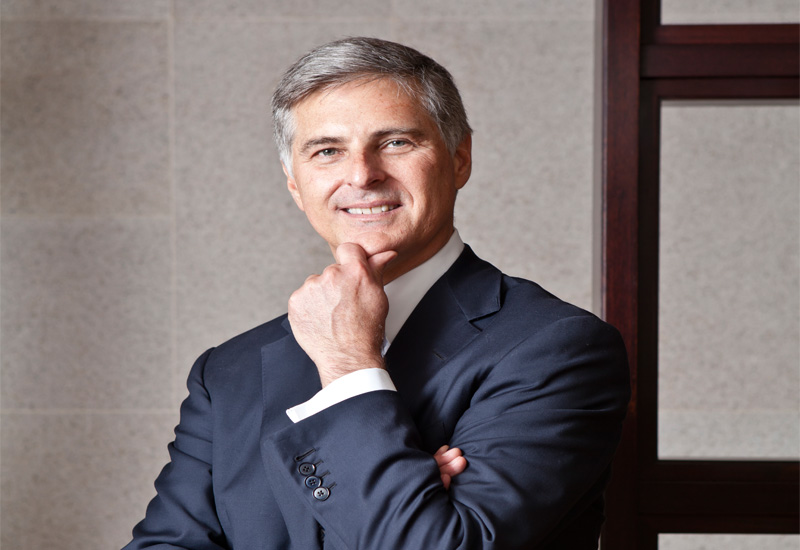 Chris Nassetta followed his father’s advice and started in the industry from the ground up. His first job was plunging toilets.
Chris Nassetta followed his father’s advice and started in the industry from the ground up. His first job was plunging toilets.
Hilton Worldwide president and chief executive officer Christopher J. Nassetta reflects on the six-year journey to the lodging industry’s largest ever IPO, revealing how he fought for the buy-in of 300,000 colleagues in order to wake up a sleeping giant
The year 2013 will long be a highlight on Hilton Worldwide’s 96-year timeline. The company opened 207 hotels, with nearly 34,000 rooms, 64% of which were developed by current owners. Another 72,000 rooms were approved for development, growing the pipeline to more than 1100 hotels, consisting of 195,000 rooms as of December 31.
Close to 102,000 of these are under construction, representing the largest number of rooms under construction in the industry in every major region of the world, according to Smith Travel Research.

| Advertisement |
The financials were strong too, with RevPar, margin and net unit growth leading to adjusted EBIDTA growth of 13% on a year over year basis to US $2210mn for the full year.
The crowning glory came in December, when backed by private equity and real estate firm Blackstone Group, Hilton Worldwide raised approximately $2.34bn in its initial public offering, rejoining the New York Stock Exchange.
The IPO was the second biggest float in 2013 and the largest ever offering for a hotel company, with the record previously set by Hyatt in 2009. Hilton Worldwide sold 117.6mn shares priced at $20 each on December 11, five million shares more than it had offered and at the upper end of the $18-$21 price range it had set.
There’s no doubting it was a stellar year but the journey to the IPO started back in 2007, when Blackstone bought Hilton Worldwide and “airlifted” in Christopher J. Nassetta, formerly president and chief executive officer of Host Hotels and Resorts, to transform the “sleepy and complacent” hotel chain.
Speaking to Hotelier Middle East six years after his appointment, and six weeks after the IPO, Nassetta recalls he had “quite a task” on his hands.
“There’s no question I came in with sort of a view of what was possible; I wouldn’t have taken the job if I didn’t think there was a lot we could do and I had a pretty good perspective.
I was an industry guy. I competed against Hilton in my Host Marriott days, I certainly competed against Hilton for money in the public environment and I thought I had a pretty good perspective on what the opportunities were,” he says.
After spending his first 90-120 days in position “flying around the world, talking to our people, our customers, our team members, our major owners”, essentially doing a SWOT analysis of the company, Nassetta remembers the situation being both “worse and better than we thought”.
“Worse in a sense that we were further behind than I think we would have guessed, better in the sense that it meant better opportunities, to an extent we could change the trajectory in the organisation, totally transform it,” he explains.
The “under-riding thesis” driving these changes, which in hindsight Nassetta says was “right in spades”, is that back in 2007, Hilton Worldwide was a “very dysfunctional organisation” — put together largely through merger and acquisition and not yet aligned.
The history is well known: in 1964 Hilton International (HI) and the original domestic US business, Hilton Hotels Corporation (HHC), became separate companies, not reunited until 2006, when HHC reacquired HI. During this 40-year period, HHC had bought brands such as Hampton, Doubletree, Embassy Suites and Homeward Suites, creating what Nassetta describes as a “very siloed organisation”.
There were other problems, related to performance, brand and growth, says Nassetta, painting a fairly bleak picture.
“Performance was mediocre, sort of average to slightly worse than average; that meant top line performance across the enterprise, that meant cost structure, ultimately bottom line performance was average,” says Nassetta.
“The next part of the under-riding thesis was brands. The brands were good but they had room to be better in terms of market share of the brands, and we had segments that we weren’t serving.
Article continues on next page ...








 Search our database of more than 2,700 industry companies
Search our database of more than 2,700 industry companies









